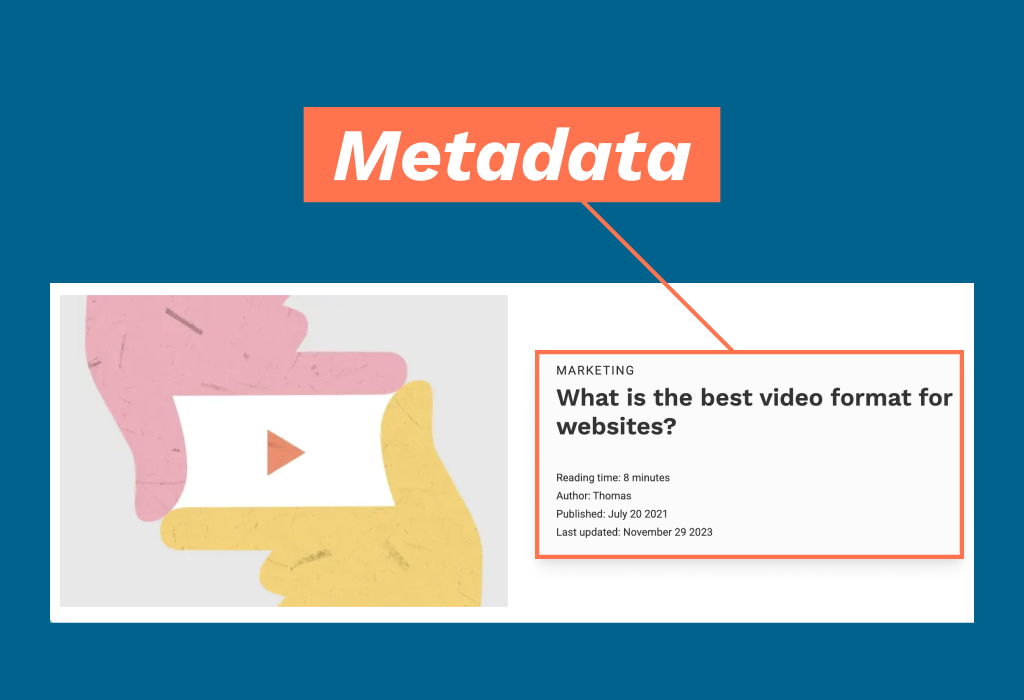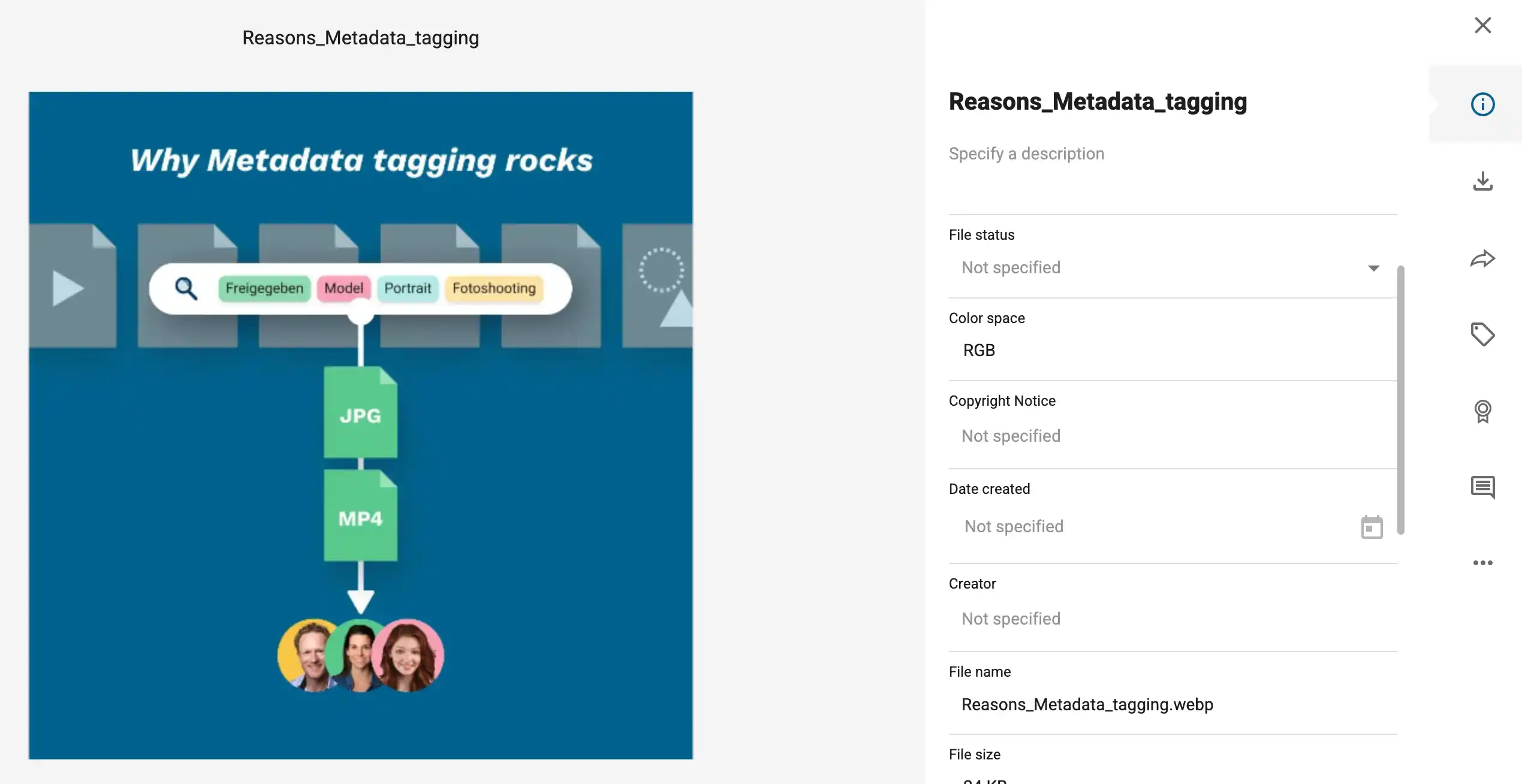Metadata gives us the opportunity to add further information directly to the media file – like the author or a title. But did you know that these metadata examples are only the tip of the iceberg? No? Then it’s time to read our article about metadata examples and learn more about their power!
The container of additional information
To summarize: Metadata is data about data. Specifically, this means it describes data in more detail and provides further information. It can also help put data into context.
An example for this would be a table. To understand what data the actual table itself contains, it needs explaining. This additional information is usually provided by the header.
But there is a plethora of all different kinds of data, depending on the format or type of medium. With digital media in particular, a lot of metadata is already added automatically and is included in the file. However, it can also be individually adapted or extended. We’ll go over how that works further down below. But if you are interested in learning more about metadata editing, you can check out our use case here.
However, metadata can also be categorized. This categorization is based on what information the metadata contains. Let's take a look at the different types of metadata.
7 Types of metadata
There are many different types of metadata that all serve different purposes. Different types of metadata are often present at the same time within the same dataset. Here we will go into more detail about 7 different metadata clusters.
1. Structural metadata
Structural metadata can indicate the hierarchical structure according to which the data is organized. In the case of a book or an article, for example, this could be the page numbers or the table of contents. They also clarify the relationship between the data.
2. Administrative metadata
Administrative metadata provides information about the possible use of the data. Who can access it and how can it be used? Administrative data primarily helps with the management of files and data and provides guidelines for correct handling.
3. Descriptive metadata
Descriptive metadata provides basic information, such as the title/name of the file, author/creator, creation date, etc. They therefore describe the content further and provide context.
4. Provenance metadata
Provenance metadata can provide information about whether the data has been edited or copied. It can also give information about the status of a file, e.g. whether it is an archived file. Provenance metadata allows you to keep an eye on the lifecycle of your files.
5. Preservation metadata
Preservation metadata is used for data maintenance. It specifies how the data should be preserved to ensure it lasts over time.
6. Definitional metadata
As the name suggests, definitional metadata provides definitions, e.g. on the vocabulary used in the data. However, it can also contain information on how the data was collected or explain calculations made.
7. Usage metadata
Usage metadata provides information on how the data is used. This can be, for example, the number of views, downloads or sales, but also time-related information such as the date and time of a click, sale, etc. It can help to predict future behavior of users and consumers.
Examples of metadata
Let's now take a look at a few formats and what metadata they typically contain.
Blog articles
A blog article like the one you are reading right now contains various metadata. This includes:

Books
Analog media contain metadata, too, such as books:
Title of the book
Blurb
Author
Table of contents
Page numbers
Sales
E-mail
Metadata that emails typically contain is:
Subject line
Sender
Recipient
Date and time sent
Number of emails opened
Files
Different file formats have different metadata. However, in the Explorer or Finder, where the files are all stored, the same information is shared across all formats, like:
File format
File size
Date and time created
Storage location
Date last opened/edited
Images
Let's take a closer look at this particular file format. Every time you take a digital photo, so-called EXIF data is created. This is the type of metadata that is stored in digital images. This includes:
Date and time taken
Camera model
Focal length
Lens
and much more
There is also the so-called IPTC data. These are not created automatically and must be added manually by the photographer.
In general, metadata can always be changed and adapted. There are various ways in which you are able do this. There are a number of different tools that can help you with this. A digital asset management software is one of them.
How can I edit metadata in pixx.io?
By clicking on a media file in your Mediaspace, various metadata is displayed in the "Information" section on the right. The administrator determines which metadata is displayed here. What is shown here is only the prioritized metadata. The admin can add many more metadata fields and decide who can edit them.

The metadata in pixx.io can also be indexed by the admin for search purposes, making it easier for users to find certain files. Moreover, it is possible to specify whether the file has already been published somewhere or still needs to be edited and how you may use it. Therefore, you as a user gain a clearer overview of how you can work with the images and whether you are allowed to publish them.
The standard metadata that can be stored in pixx.io includes:
File name and size
Creator
Date and time
Copyright notice
File status
Terms of use
And many more
Admins can also create custom metadata fields in pixx.io. However, these cannot be transferred into external applications such as Photoshop.
pixx.io offers you the possibility to customize your metadata and adapt it to your needs. You decide what is important to you and which information you want to be able to see at first glance.
Conclusion
In addition to the examples we have mentioned, there is a wide range of other examples of metadata. You can find them everywhere and anywhere, not only in the digital, but also in the analog world. Metadata is useful for providing context, creating an overview or giving technical information.
With the right software, you can customize and extend your metadata. You therefore could use pixx.io. Start your 14-day trial period today and test pixx.io for free and without obligation!
Valerie
Valerie always wanted to do "something with media", but ended up studying German and English instead. This is how she discovered her interest in language. Her work as a content editor at pixx.io allows her to combine both - language and media.





